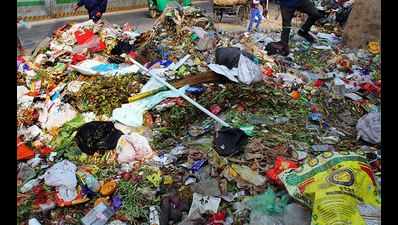- News
- City News
- delhi News
- In Mehrauli, ruins and rubbish abound
Trending
This story is from April 15, 2017
In Mehrauli, ruins and rubbish abound

Representative image.
NEW DELHI: Mehrauli once was the capital of the Delhi sultans. It was named after the Persian words ‘mehr’ and ‘auliya’, meaning ‘grace of the saint’. In the last five years, though, civic authorities have been anything but graceful towards this area.
An important place in terms of heritage, Mehrauli has several medieval ruins dating as early as the 11th century when the Tomars ruled Delhi.But the most famous heritage building here is the world heritage site of Qutub Minar. Naturally, it registers a heavy footfall of tourists, Indian and foreign alike. But encroachments and unauthorised constructions have eroded Mehrauli’s charm.
Delimitation has also massively changed the contours of this area. Mehrauli had four wards earlier; this time, though, it would send only three councillors to the south corporation from Lado Sarai, Mehrauli and Vasant Kunj as the Kishangarh ward has been merged with Mehrauli.
The sitting councillors rue that haphazardly done geographical redistribution of localities has made administration even more difficult. “Not only has the geographical area has increased, but now, even travelling within the ward will become difficult. Our ward has Saket at one end and Kusumpur on the other with a distance of 12 km. With limited funds, the new councillors will find it difficult to manage these areas” said Anita Chaudhary the current corporator from Lado sarai.
Chaudhary argued, “The sewerage system was installed 30 years ago when six to seven people lived in a house. But now the multi-storey buildings have 50-60 people.”
Begum Zakiya (35) of Mehrauli said street cleaning is infrequent and the tourist load adds to the garbage. Heritage baolis have become dumping yards.
Although not under the purview of the corporation, the area also suffers from water crisis. Underground water is unusable, and a parallel water economy and supply of drinking water from a bottling plant has cropped up. Kishangarh resident Ramesh Chandra (58) said people are forced to pay Rs 2,000 for water tankers.
Once dotted with sarais or inns, the area now has many farmhouses belonging to the rich. These house parties, weddings etc and result in a traffic nightmare.
Vasant Kunj and Saket have good infrastructure, but have a massing parking problem. The local councillor, though, says the corporation can’t help as it doesn’t own land.
Slum clusters in Kusumpur Pahadi and Motilal Nehru Camp have terrible drainage with the only big drain choked. Councillors say they can’t spend on these areas as the existing rules bar them. Vasant Kunj’s Congress councillor, Om Wati, said it was because of “step-motherly treatment by BJP”. She said, “Almost half of the area’s safai karamcharis were removed. I have been able to create community centres, meeting halls, public toilets and herbal parks in Ber Sarai and Mehsudpur.”
An important place in terms of heritage, Mehrauli has several medieval ruins dating as early as the 11th century when the Tomars ruled Delhi.But the most famous heritage building here is the world heritage site of Qutub Minar. Naturally, it registers a heavy footfall of tourists, Indian and foreign alike. But encroachments and unauthorised constructions have eroded Mehrauli’s charm.
Delimitation has also massively changed the contours of this area. Mehrauli had four wards earlier; this time, though, it would send only three councillors to the south corporation from Lado Sarai, Mehrauli and Vasant Kunj as the Kishangarh ward has been merged with Mehrauli.
The sitting councillors rue that haphazardly done geographical redistribution of localities has made administration even more difficult. “Not only has the geographical area has increased, but now, even travelling within the ward will become difficult. Our ward has Saket at one end and Kusumpur on the other with a distance of 12 km. With limited funds, the new councillors will find it difficult to manage these areas” said Anita Chaudhary the current corporator from Lado sarai.
Haphazard growth has turned the urbanised villages like Lado Sarai, Ber Sarai and Katwaria Sarai into rent havens. The four to five storied buildings and narrow lanes house a large number of tenants, most of them students and company workers, putting the existing civic infrastructure under tremendous pressure. Hari Singh (60) from Katwaria Sarai said, “Sewage has created an acute sanitation crisis. The lanes get frequently, leading to mosquito breeding. No wonder we had so many chikungunya cases last year.”
Chaudhary argued, “The sewerage system was installed 30 years ago when six to seven people lived in a house. But now the multi-storey buildings have 50-60 people.”
Begum Zakiya (35) of Mehrauli said street cleaning is infrequent and the tourist load adds to the garbage. Heritage baolis have become dumping yards.
Although not under the purview of the corporation, the area also suffers from water crisis. Underground water is unusable, and a parallel water economy and supply of drinking water from a bottling plant has cropped up. Kishangarh resident Ramesh Chandra (58) said people are forced to pay Rs 2,000 for water tankers.
Once dotted with sarais or inns, the area now has many farmhouses belonging to the rich. These house parties, weddings etc and result in a traffic nightmare.
Vasant Kunj and Saket have good infrastructure, but have a massing parking problem. The local councillor, though, says the corporation can’t help as it doesn’t own land.
Slum clusters in Kusumpur Pahadi and Motilal Nehru Camp have terrible drainage with the only big drain choked. Councillors say they can’t spend on these areas as the existing rules bar them. Vasant Kunj’s Congress councillor, Om Wati, said it was because of “step-motherly treatment by BJP”. She said, “Almost half of the area’s safai karamcharis were removed. I have been able to create community centres, meeting halls, public toilets and herbal parks in Ber Sarai and Mehsudpur.”
End of Article
FOLLOW US ON SOCIAL MEDIA










